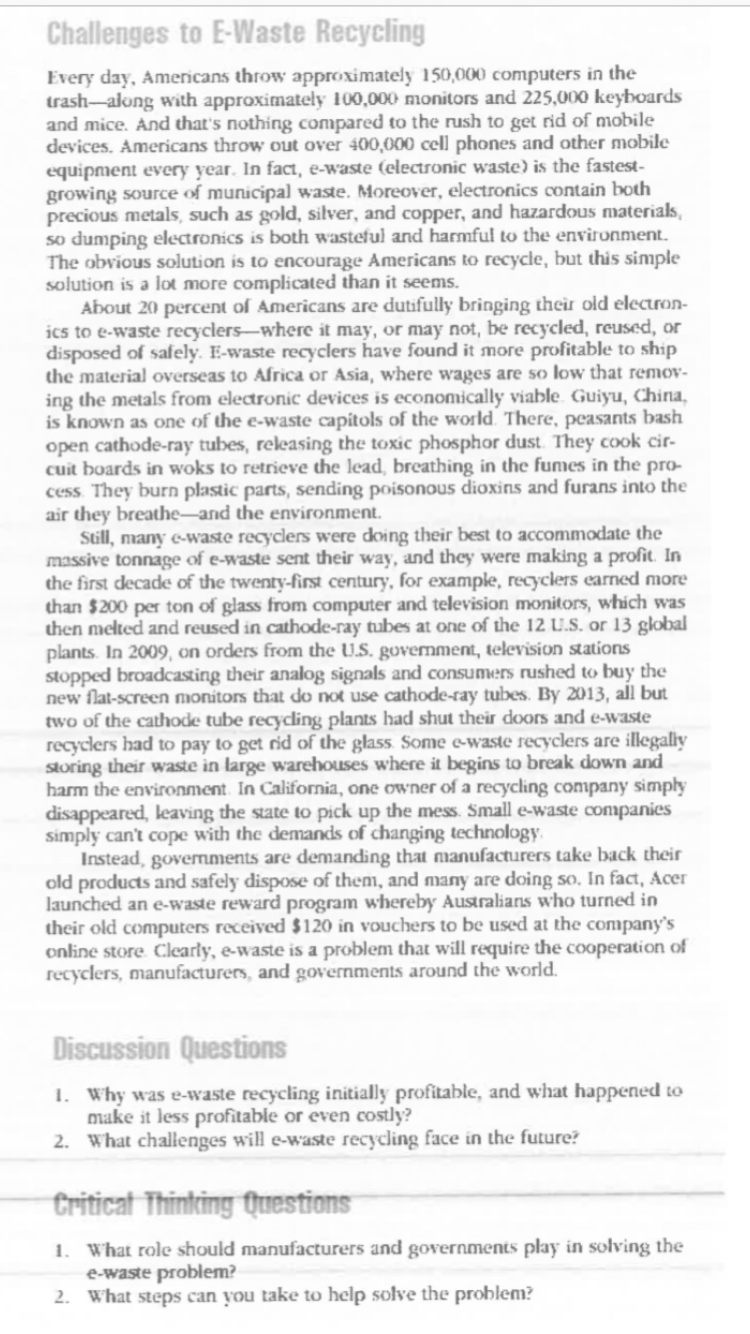Challenges to E-Waste Recycling Every day, Americans throw approximately 150,000 computers in the trash-along with approximately 100,000 monitors and 225,000 keyboards and mice. And that's nothing compared to the rush to get rid of mobile devices. Americans throw out over 400,000 cell phones and other mobile equipment every year. In fact, e-waste (electronic waste) is the fastest- growing source of municipal waste. Moreover, electronics contain both precious metals, such as gold, silver, and copper, and hazardous materials, so dumping electronics is both wasteful and harmful to the environment. The obvious solution is to encourage Americans to recycle, but this simple solution is a lot more complicated than it seems. About 20 percent of Americans are dutifully bringing their old electron- ics to e-waste recyclers-where it may, or may not, be recycled, reused, or disposed of safely. E-waste recyclers have found it more profitable to ship the material overseas to Africa or Asia, where wages are so low that remov- ing the metals from electronic devices is economically viable Guiyu, China, is known as one of the e-waste capitols of the world. There, peasants bash open cathode-ray tubes, releasing the toxic phosphor dust. They cook cir- cuit boards in woks to retrieve the lead, breathing in the fumes in the pro- cess. They burn plastic parts, sending poisonous dioxins and furans into the air they breathe-and the environment. Still, many e-waste recyclers were doing their best to accommodate the massive tonnage of e-waste sent their way, and they were making a profit. In the first decade of the twenty-first century, for example, recyclers earned more than $200 per ton of glass from computer and television monitors, which was then melted and reused in cathode-ray tubes at one of the 12 U.S. or 13 global plants. In 2009, on orders from the U.S. government, television stations stopped broadcasting their analog signals and consumers rushed to buy the new flat-screen monitors that do not use cathode-ray tubes. By 2013, all but two of the cathode tube recycling plants had shut their doors and e-waste recyclers had to pay to get rid of the glass. Some c-waste recyclers are illegally storing their waste in large warehouses where it begins to break down and harm the environment. In California, one owner of a recycling company simply disappeared, leaving the state to pick up the mess. Small e-waste companies simply can't cope with the demands of changing technology. Instead, governments are demanding that manufacturers take back their old products and safely dispose of them, and many are doing so. In fact, Acer launched an e-waste reward program whereby Australians who turned in their old computers received $120 in vouchers to be used at the company's online store. Clearly, e-waste is a problem that will require the cooperation of recyclers, manufacturers, and governments around the world. Discussion Questions 1. Why was e-waste recycling initially profitable, and what happened to make it less profitable or even costly? 2. What challenges will e-waste recycling face in the future? Critical Thinking Questions 1. What role should manufacturers and governments play in solving the e-waste problem? 2. What steps can you take to help solve the







